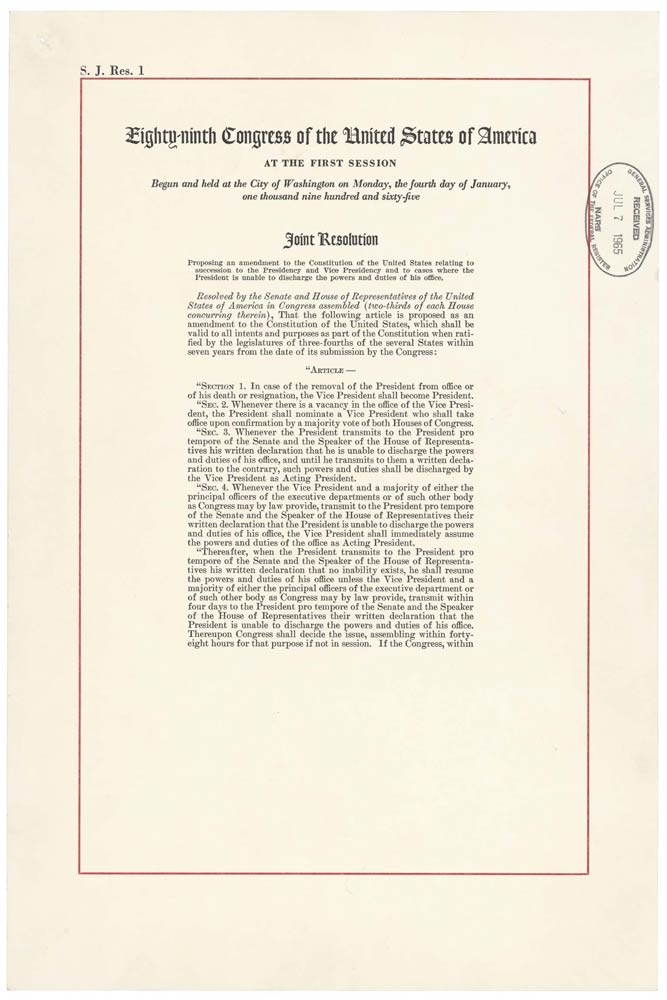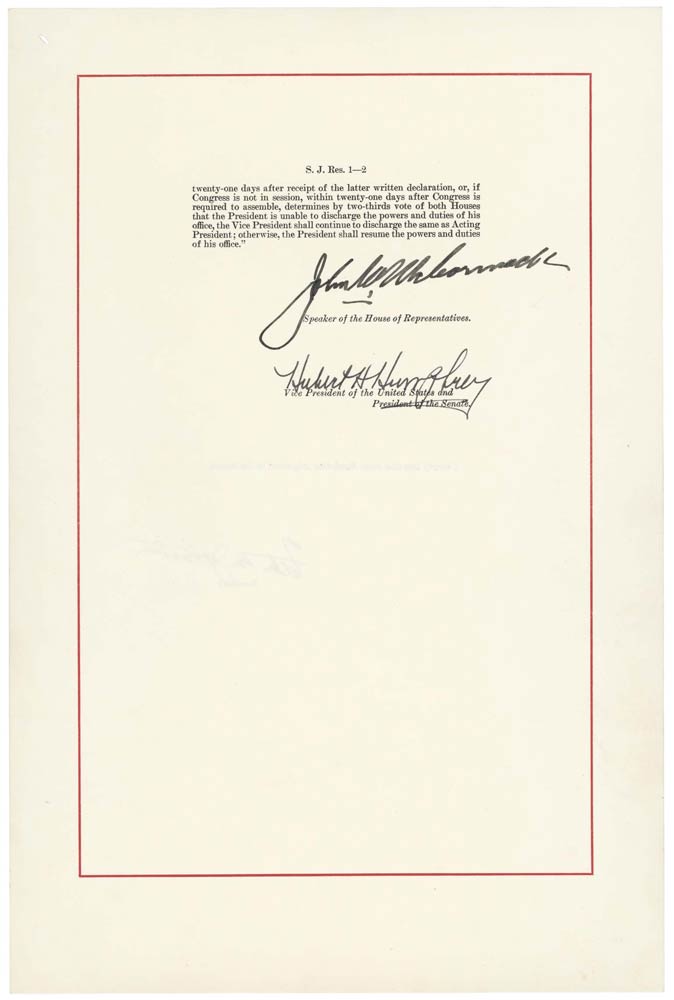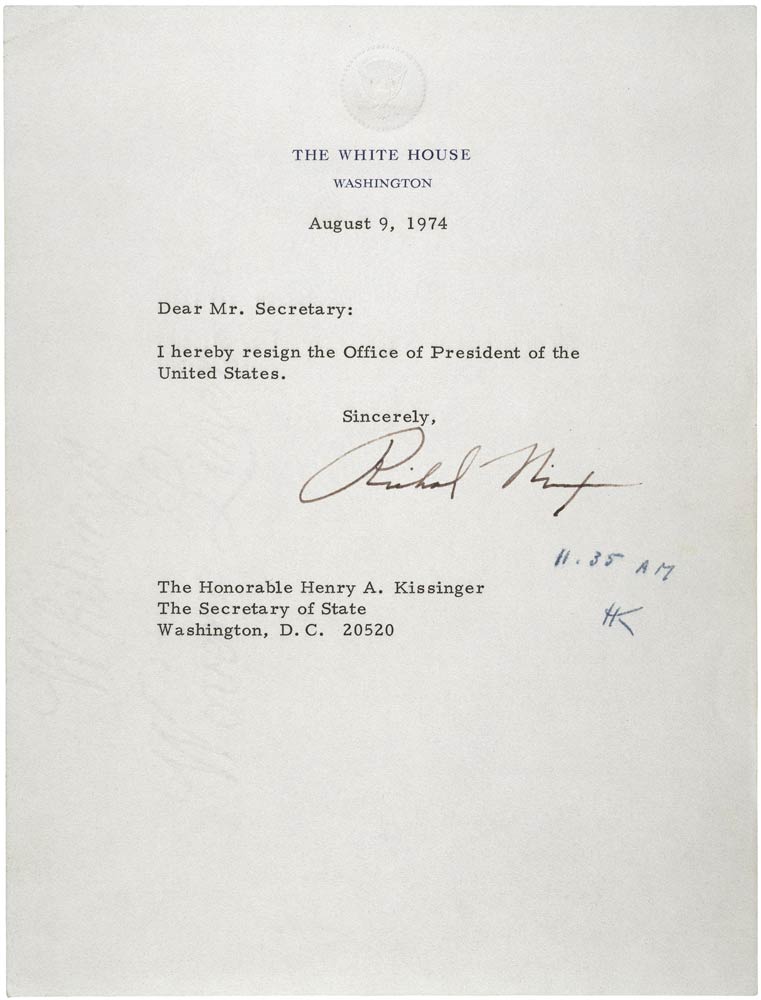| United States Constitution | |
|---|---|
 |
|
| The U.S. Constitution | |
| Preamble | |
| Articles of the Constitution | |
| I ‣ II ‣ III ‣ IV ‣ V ‣ VI ‣ VII | |
| Amendments to the Constitution | |
| Bill of Rights | |
| I ‣ II ‣ III ‣ IV ‣ V ‣ VI ‣ VII ‣ VIII ‣ IX ‣ X | |
| Additional Amendments | |
| XI ‣ XII ‣ XIII ‣ XIV ‣ XV ‣ XVI ‣ XVII ‣ XVIII ‣ XIX ‣ XX ‣ XXI ‣ XXII ‣ XXIII ‣ XXIV ‣ XXV ‣ XXVI ‣ XXVII | |
| View the Full Text | |
| Original Constitution | |
| Bill of Rights | |
| Additional Amendments |
The Twenty-Fifth Amendment to the United States Constitution was adopted on February 25, 1967, to delineate the succession of duties of the President of the United States of America in instances in which the existing President is unable to discharge the duties of the office, for various reasons. It further sets forth the protocol to be followed in the event that the incapacity of the President is temporary, and how the office of the Vice President will be utilized and affected in all matters pertaining to the President’s capacity to serve.
Text
Section 1. In case of the removal of the President from office or of his death or resignation, the Vice President shall become President.
Section 2. Whenever there is a vacancy in the office of the Vice President, the President shall nominate a Vice President who shall take office upon confirmation by a majority vote of both Houses of Congress.
Section 3. Whenever the President transmits to the President pro tempore of the Senate and the Speaker of the House of Representatives his written declaration that he is unable to discharge the powers and duties of his office, and until he transmits to them a written declaration to the contrary, such powers and duties shall be discharged by the Vice President as Acting President.
Section 4. Whenever the Vice President and a majority of either the principal officers of the executive departments or of such other body as Congress may by law provide, transmit to the President pro tempore of the Senate and the Speaker of the House of Representatives their written declaration that the President is unable to discharge the powers and duties of his office, the Vice President shall immediately assume the powers and duties of the office as Acting President.
Thereafter, when the President transmits to the President pro tempore of the Senate and the Speaker of the House of Representatives his written declaration that no inability exists, he shall resume the powers and duties of his office unless the Vice President and a majority of either the principal officers of the executive department or of such other body as Congress may by law provide, transmit within four days to the President pro tempore of the Senate and the Speaker of the House of Representatives their written declaration that the President is unable to discharge the powers and duties of his office. Thereupon Congress shall decide the issue, assembling within forty-eight hours for that purpose if not in session. If the Congress, within twenty-one days after receipt of the latter written declaration, or, if Congress is not in session, within twenty-one days after Congress is required to assemble, determines by two-thirds vote of both Houses that the President is unable to discharge the powers and duties of his office, the Vice President shall continue to discharge the same as Acting President; otherwise, the President shall resume the powers and duties of his office.
Purpose
This amendment clarifies and replaces the ambiguous language that originally addressed this issue, and which was contained in Article II of the Constitution. In this original text, the scope of responsibility of the Vice President was unclear when considered in the context of the President’s inability to serve. Some interpreted it to mean that the Vice President literally became President, regardless of the circumstances. Others asserted that it only meant that the Vice President would become “Acting President” and would refer the office back to the President at such time as when the President’s ability to serve was restored. Additionally, with the passage of time came the realization that the original language of the Constitution did not provide for a successor to the office of the Vice President in the event of Presidential succession.
Foundation
The need for a constitutional amendment manifested in 1841 when President William Henry Harrison died while in office. With no clear succession mandate in place, it was suggested that the Vice President, John Tyler, be appointed as “Acting President”. Whether borne from egotism, or the practical recognition that an Acting President would be ineffective at a time when the country had no president at all, John Tyler refused to acknowledge the title of Acting President, and declared himself to be the President of the United States by virtue of succession of the office. While dissenters may have existed, no formal protests were filed, and the Tyler Precedent came into being.
As the years passed, Presidents encountered situations, including health problems, that rendered them unable to discharge their duties as President temporarily. For instance, President Woodrow Wilson suffered a stroke that left him unable to serve in the capacity as President, and no one officially assumed the duties of the President afterwards.
Another problem was slowly rearing its head as far as coverage of the Office of the Vice President, in that there was no provision for success of this office when the Vice President was called upon to either serve as Acting President, or needed to serve as President. For instance, for four years following the death of President Franklin D. Roosevelt, the United States had no Vice President at all, and no provisions for appointment of one.
As the importance of this issue rose to the forefront, two proposals rose in prominence as possible solutions.
Keating-Kefauver
The Keating-Kefauver proposed a Constitutional Amendment that would provide for the empowerment of Congress to pass legislation that would establish methodology for determining the incapacity of a President to discharge the duties of the office.
This proposal did not actually provide a Constitutional basis for determining the capacity of the President. It referred the matter to Congress for legislative action.
Bayh-Celler
This proposal was prepared and presented out of concern that the Keating-Kefauver proposal would provide an imbalance of power to the Congress in determining the capacity of the President. Bayh-Celler, which would later become the Twenty-Fifth Amendment, was a cooperative effort between subcommittees of the House and Senate.
Bayh-Celler set forth specific protocol for how a President could be declared disabled, thus moving the Vice President to the office of “Acting President”. An additional protocol was established in Bayh-Celler, or the 25th Amendment, for declaring the President to be no longer disabled and restored to office.
Another provision in Bayh-Celler addressed the issue of ensuring that the office of the Vice President was filled in the event of a presidential vacancy. This particular provision was not addressed in Keating-Kefauver.
In Summary
As is the case with any organization, the matter of succession of leadership is crucial to the survival of the organization in the event of an illness, death, or disability of the current head of operations. It is the same with the United States. The balance of power that was so carefully crafted by the founding fathers can only be preserved by the establishment of lines of succession. The Twenty-Fifth Amendment of the United States Constitution serves that function exactly.


